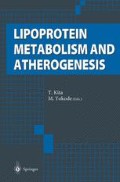Summary
Lysophosphatidylcholine (LPC) accumulates in inflammatory tissues, where neutrophils are recruited to generate superoxide anions (O2™). Here, we show that LPC stimulates O2™ generation in human neutrophils and that the activity is inhibited with phosphatidylinositol 3-kinase (PI3 kinase) inhibitors, but not with protein kinase C (PKC) inhibitors. Furthermore, we demonstrate that LPC activates PI3 kinase in neutrophils. Thus, LPC might contribute to host defense by generating O2™ in neutrophils through PI3 kinase activation, but not through PKC activation.
Access this chapter
Tax calculation will be finalised at checkout
Purchases are for personal use only
References
Chanock SJ, Benna JEI, Smith RM, and Babior BM (1994) The respiratory Burst Oxidase. J Biol Chem 269, 24519–24522
Wientjes FB, and Segel AW (1995) NADPH oxidase and the respiratory burst. Seminars in Cell Biol 6, 357–365
Faust LRP, Benna JEI, Babior BM, and Chanock SJ (1995) The Phosphorylation Targets of p47phox, a Subunit of the Respiratory Burst Oxidase. J Clin Invest 96, 1499–1505
Thelen M, Wymann MP, and Langen H (1994) Wortmannin binds specifically to 1-phosphatidylinositol 3-kinase while inhibiting guanine nucleotide-binding protein-coupled receptor signaling in neutrophil leukocytes. Proc Natl Acad Sci USA 92, 4960–4964
Okada T, Sakuma L., Fukui Y, Hazeki O, and Ui M (1994) Blockage of Chemotactic Peptide-induced Stimulation of Neutrophils by Wortmannin as a Result of Selective Inhibition of Phosphatidylinositol 3-Kinase. J Biol Chem 269, 3563–3567
Rane MJ, Carrithers SL., Arthur JM, Klein JB, and McLeish KR (1997) Formyl Peptide Receptors Are Coupled to Multiple Mitogen-Activated Protein kinase Cascades by Distinct Signal Transduction Pathways. J Immunol 159, 5070–5078
Vlahos CJ, Matter WF, Brown RF, Traynor-Kaplan AE, Heyworth PG, Prossnitz ER, Ye RD, Marder P, Schern JA, Rothfuss KJ, Serlin BS, and Simpson PJ (1995) Investigation of Neutrophil Signal Transduction Using a Specific Inhibitor Phosphatidylinositol 3-kinase. J Immunol 154, 2413–2422
Kaplan DR, Whitman M, Schaffhausenm B, Pallas DC, White L., Cantley L., and Roberts TM (1987) Common elements in growth factor stimulation and oncogenic transformation: 85 kd phosphoprotein and phosphatidylinositol kinase activity. Cell 50, 1021–1029
Oishi K, Raynor LR, Charp PA, and Kuo JF (1988) Regulation of Protein Kinase C by Lysophospholipids. J Biol Chem 263, 6865–6871
Ohara Y, Peterson TE, Zheng B, Kuo JF, and Harrison DG (1994) Lysophosphatidylcholine Increases Vascular Superoxide Anion Production via Protein Kinase C Activation. Arterioscler Thromb 14, 1007–1013
Chen Y, Morimoto S, Kitano S, Koh E, Fukuo K, Jiang B, Chen S, Yasuda O, Hirotani A, and Ogihara T (1995) Lysophosphatidylcholine causes Ca2+ influx, enhanced DNA synthesis and cytotoxicity in cultured vascular smooth muscle cells. Atherosclerosis 112, 69–76
Martens JS, Reiner NE, Herrera-Velit P, and Steinbrecher UP (1998) Phosphatidylinositol 3-Kinase Is Involved in the Induction of Macrophage Growth by Oxidized Low Density Lipoprotein. J Biol Chem 273, 4915–4920
Maeba R, Maruyama A, Tarutani O, Ueta N, and Shimasaki H. (1995) Oxidized low-density lipoprotein induces the production the superoxide by neutrophils. FEBS Lett 377, 309–312
Author information
Authors and Affiliations
Editor information
Editors and Affiliations
Rights and permissions
Copyright information
© 2000 Springer-Verlag Tokyo
About this paper
Cite this paper
Nishioka, H., Horiuchi, H., Arai, H., Kita, T. (2000). Lysophosphatidylcholine generates superoxide anions through activation of phosphatidylinositol 3-kinase in human neutrophils. In: Kita, T., Yokode, M. (eds) Lipoprotein Metabolism and Atherogenesis. Springer, Tokyo. https://doi.org/10.1007/978-4-431-68424-4_56
Download citation
DOI: https://doi.org/10.1007/978-4-431-68424-4_56
Publisher Name: Springer, Tokyo
Print ISBN: 978-4-431-68426-8
Online ISBN: 978-4-431-68424-4
eBook Packages: Springer Book Archive

